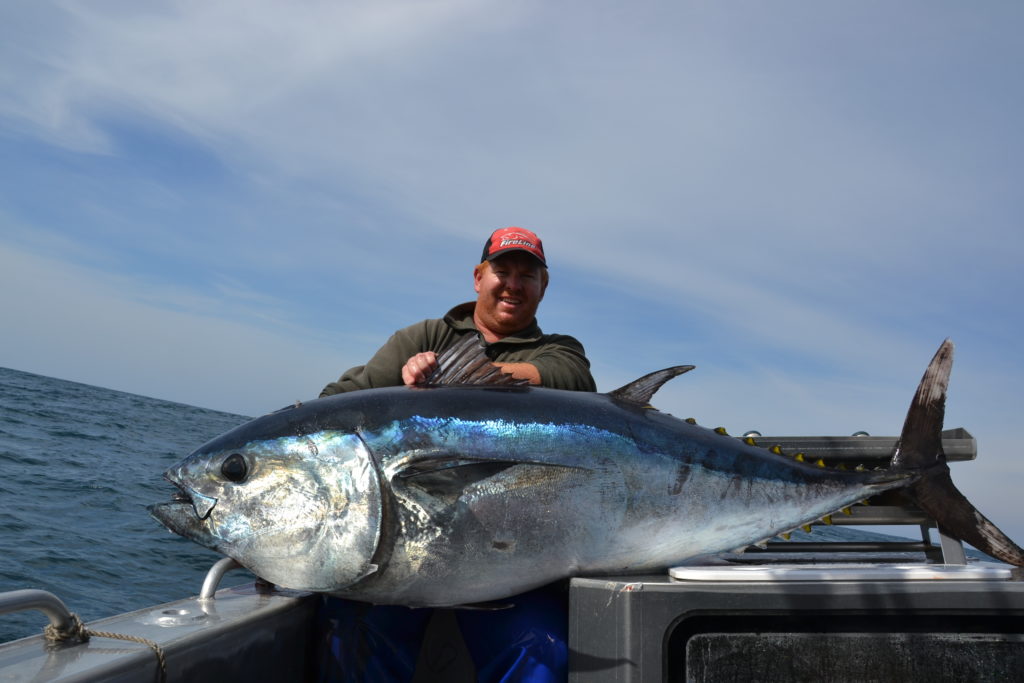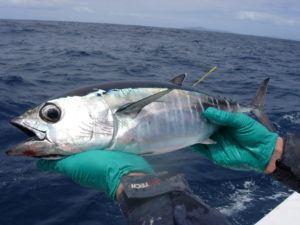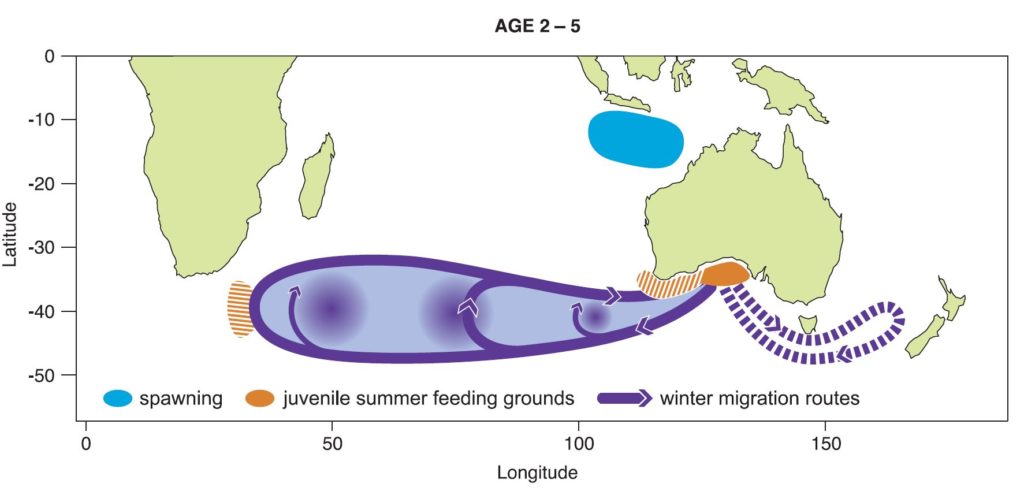
Blimey that’s a big bluefin! Matt Bell with the 175 cm southern bluefin tuna he caught near Port MacDonnell. Image: Matt Bell and Dennis Heinicke
We have been reunited with an old friend. We met a long time ago, 22 years in fact, and we certainly left our mark during that first meeting. Now with a long passage of time behind us, we are keen to find where she has been all this time.
We are, of course, talking about this stunning southern bluefin tuna (SBT). Tagged in 1993, the fish was reeled in by avid fisherman Matt Bell with the help of Skipper Dennis Heinicke, near Port MacDonnell last week.
We first met ‘Bluey’ when she was approximately two years old. At the time, our scientists were out on the open oceans teaming up with the Commission for the Conservation of Southern Bluefin Tuna to tag over 11,000 SBT in the Great Australian Bight (GAB).

Here’s looking at you kid. An example of the small yellow tags poking out of the dorsal fin of a juvenile SBT. This isn’t Bluey, but you can appreciate how big she has grown.
Thanks to our citizen scientists Dennis and Matt, Bluey is back, and my how she has grown. The fish has more than doubled in size. She weighs 102 kgs and has had a decent growth spurt, from 60 cm to a behemoth 191 cm total length – or if you are a purist for measurements, her ‘fork length‘ is 175 cm (that’s still 5’ 7”, or taller than Tom Cruise).
Other than growing up to be taller than Hollywood celebrities, what does an SBT do in twenty years? From what we can tell, Bluey has led quite an interesting life.
We know that Bluey spent large parts of her life travelling the southern seas. And although she was reeled in 800 km east of where she was originally caught and tagged, we know from our other more sophisticated SBT tags that Bluey has been undertaking large migrations. As a juvenile, these migrations took her from the GAB to the Indian Ocean; upon maturing, she travelled between the Southern Ocean and the Indian Ocean, just south of Indonesia. It is here that adult SBT spawn each year.

Schematic of juvenile SBT migrations, showing the distance and patterns of the SBT movement in their youth.
Dennis and Matt have not only been helping our researchers by reporting and returning Bluey’s tags, but they have also collected some very important samples of the fish. By looking at Bluey’s otoliths (deposits in the ear) we can determine and verify her age. By looking at her ovaries we can determine her sex and reproductive history. And by analysing the chemical composition of Bluey’s muscles, we can know her diet.
Why are we so excited about this find? Because we rely on the cooperation of commercial and recreational fishers to find the tags, and in the vastness of Southern Ocean, finding a tagged fish after such a long time is like finding a needle in a haystack.
Remember, Bluey doesn’t have a social media profile (MySpace wasn’t even around back then) so checking in and finding out what’s been happening is a bit more complicated than trawling through her Facebook Timeline. Now that the tags and the fish are back with our scientists, we have an opportunity to learn more about the life of this particular bluefin and the SBT population in general.
These insights, will help with our ongoing research and conservation efforts in our southern oceans. The information is invaluable as we seek to understand how exploration and extraction activities in the ‘Bight’ might affect SBT populations.
We will now add Bluey’s profile to the data we’ve gathered after almost 50 years of archival tagging efforts.
We’ve recently been tagging juvenile SBT (similar to the two year old Bluey) with ‘smart’ archival tags that gather detailed data on the movements, diving behaviour, habitats, and feeding of the SBT. By comparing the data from these tags to similar tags we deployed during the 1990s and 2000s, we can investigate the impacts of oil and gas exploration and extraction on juvenile SBT during the period they ‘summer’ in the GAB.
To learn more about Bluey, you can listen to a recent interview Dr Campbell Davies conducted with ABC Radio Hobart where he speaks more about tagging and our research. And if you would like more information about our SBT tagging efforts you can visit our fisheries page.
If you consider yourself a budding citizen scientist, and you do happen upon one of our tags during your fishing adventures, we’d love to hear from you. There are prizes and giveaways for returned tags, plus the gratitude of our scientists and the knowledge you are furthering our understanding of these incredible creatures.
Information on how to return tags to us and the details we need are in the form below.
To the citizen scientist go the spoils. Details of the rewards and information you’ll need to help us with our Southern Bluefin Tuna tagging program.



28th April 2016 at 5:41 pm
Great to see such a brilliant fish that has survived many close encounters in the open ocean. I often see guys hollering and having a great time catching a good fish which I do as well. Only thing is stepping back and understanding the fish is in a battle for its life and the fisherman is just having sport that’s why great care must be used when handling fish especially a fish like Bluey. Respect is what needs to be remembered here. Personally I release all the big ones and only keep a small one for the pan.
I luckily have fished for some 55 years so far and hope to carry on.
5th May 2015 at 10:49 am
Bluey was not only taller/longer than Tom Cruise, but she would also be smarter!
3rd May 2015 at 11:17 am
nothing more pathetic than ill informed , couch potato, tree huggers , if you want to actually do some good , like this fisherman here , get off your butt and get out there and do some tagging…..he’s done way more for their cause than you whiners ever will.
5th May 2015 at 3:55 pm
As the article makes clear, he didn’t tag it, that was done as part of a scientific survey that he played no part in. Kudos to the fisherman for reporting the tag, but catch-and-release should be required for endangered species.
3rd May 2015 at 10:12 am
The tone of this article is kinda creepy. They’re acting like the fish is their best buddy but they obviously have no regard for its wellbeing. Surely it’s better to release her and keep tracking. Sounds like these “scientists” are just glorified fishermen…
4th May 2015 at 12:07 pm
Dear Josie,
You and others might be interested in hearing more about we do (and don’t) learn from different sorts of tags and other things about SBT here::https://soundcloud.com/936-abc-hobart/bluey-the-prodigal-tuna-returns-after-20-years. It is a follow up interview we did with the ABC.
Regards
Campbell
5th May 2015 at 2:54 am
Right you are, Josie. Plainly, they have no concern for individual animal well-being. To them they are merely ‘specimens,’ not sentient beings deserving of genuine respect and freedom from needless and intentional harm. They actually invite, reward and celebrate the needless and intentional harm of these sentient animals.
27th April 2016 at 10:13 am
The problem with your animal rights or animal liberation philosophies Mary and Josie is that you have no scientific basis upon which to base your sentience claims – Finding Nemo was a movie, not a documentary. Another way of looking at it is not only did these fishers and scientists obtain important scientific information, big bluefin tuna must eat at least 1-2% of their body weight a day of other fish. That is, by taking the fish they have saved dozens of other “innocent” marine creatures that otherwise would have been crushed and dismembered by this fish each day. Animal rights and liberation philosophy breaks down wherever wild animals encounter predation in a natural food chain, so your animal rights prejudices are flawed and have no place in the real world. For more on this, see the numerous problems relating to animal rights ethics outlined by Fox in his theory of general ethics at http://www.warwickfox.com/files/2007_sage_-_probs_for_ge.pdf